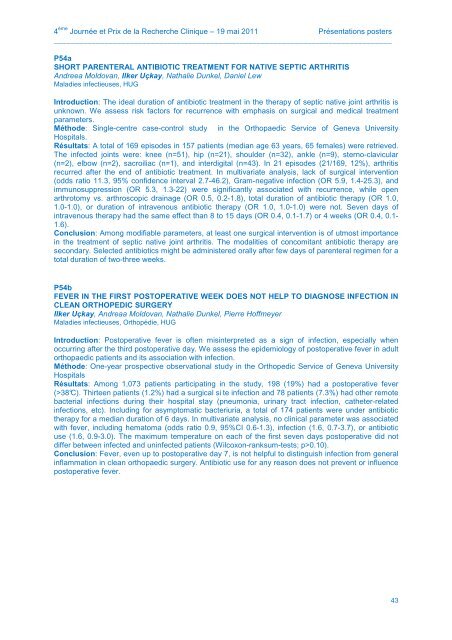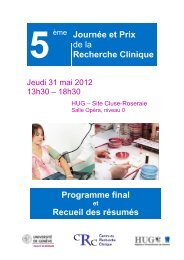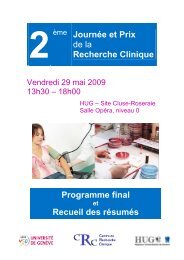Programme final et Recueil des résumés - Centre de recherche ...
Programme final et Recueil des résumés - Centre de recherche ...
Programme final et Recueil des résumés - Centre de recherche ...
Create successful ePaper yourself
Turn your PDF publications into a flip-book with our unique Google optimized e-Paper software.
4 ème Journée <strong>et</strong> Prix <strong>de</strong> la Recherche Clinique – 19 mai 2011 Présentations posters<br />
________________________________________________________________________________<br />
P54a<br />
SHORT PARENTERAL ANTIBIOTIC TREATMENT FOR NATIVE SEPTIC ARTHRITIS<br />
Andreea Moldovan, Ilker Uçkay, Nathalie Dunkel, Daniel Lew<br />
Maladies infectieuses, HUG<br />
Introduction: The i<strong>de</strong>al duration of antibiotic treatment in the therapy of septic native joint arthritis is<br />
unknown. We assess risk factors for recurrence with emphasis on surgical and medical treatment<br />
param<strong>et</strong>ers.<br />
Métho<strong>de</strong>: Single-centre case-control study in the Orthopaedic Service of Geneva University<br />
Hospitals.<br />
Résultats: A total of 169 episo<strong><strong>de</strong>s</strong> in 157 patients (median age 63 years, 65 females) were r<strong>et</strong>rieved.<br />
The infected joints were: knee (n=51), hip (n=21), shoul<strong>de</strong>r (n=32), ankle (n=9), sterno-clavicular<br />
(n=2), elbow (n=2), sacroiliac (n=1), and interdigital (n=43). In 21 episo<strong><strong>de</strong>s</strong> (21/169, 12%), arthritis<br />
recurred after the end of antibiotic treatment. In multivariate analysis, lack of surgical intervention<br />
(odds ratio 11.3, 95% confi<strong>de</strong>nce interval 2.7-46.2), Gram-negative infection (OR 5.9, 1.4-25.3), and<br />
immunosuppression (OR 5.3, 1.3-22) were significantly associated with recurrence, while open<br />
arthrotomy vs. arthroscopic drainage (OR 0.5, 0.2-1.8), total duration of antibiotic therapy (OR 1.0,<br />
1.0-1.0), or duration of intravenous antibiotic therapy (OR 1.0, 1.0-1.0) were not. Seven days of<br />
intravenous therapy had the same effect than 8 to 15 days (OR 0.4, 0.1-1.7) or 4 weeks (OR 0.4, 0.1-<br />
1.6).<br />
Conclusion: Among modifiable param<strong>et</strong>ers, at least one surgical intervention is of utmost importance<br />
in the treatment of septic native joint arthritis. The modalities of concomitant antibiotic therapy are<br />
secondary. Selected antibiotics might be administered orally after few days of parenteral regimen for a<br />
total duration of two-three weeks.<br />
P54b<br />
FEVER IN THE FIRST POSTOPERATIVE WEEK DOES NOT HELP TO DIAGNOSE INFECTION IN<br />
CLEAN ORTHOPEDIC SURGERY<br />
Ilker Uçkay, Andreaa Moldovan, Nathalie Dunkel, Pierre Hoffmeyer<br />
Maladies infectieuses, Orthopédie, HUG<br />
Introduction: Postoperative fever is often misinterpr<strong>et</strong>ed as a sign of infection, especially when<br />
occurring after the third postoperative day. We assess the epi<strong>de</strong>miology of postoperative fever in adult<br />
orthopaedic patients and its association with infection.<br />
Métho<strong>de</strong>: One-year prospective observational study in the Orthopedic Service of Geneva University<br />
Hospitals<br />
Résultats: Among 1,073 patients participating in the study, 198 (19%) had a postoperative fever<br />
(>38°C). Thirteen patients (1.2%) had a surgical si te infection and 78 patients (7.3%) had other remote<br />
bacterial infections during their hospital stay (pneumonia, urinary tract infection, cath<strong>et</strong>er-related<br />
infections, <strong>et</strong>c). Including for asymptomatic bacteriuria, a total of 174 patients were un<strong>de</strong>r antibiotic<br />
therapy for a median duration of 6 days. In multivariate analysis, no clinical param<strong>et</strong>er was associated<br />
with fever, including hematoma (odds ratio 0.9, 95%CI 0.6-1.3), infection (1.6, 0.7-3.7), or antibiotic<br />
use (1.6, 0.9-3.0). The maximum temperature on each of the first seven days postoperative did not<br />
differ b<strong>et</strong>ween infected and uninfected patients (Wilcoxon-ranksum-tests; p>0.10).<br />
Conclusion: Fever, even up to postoperative day 7, is not helpful to distinguish infection from general<br />
inflammation in clean orthopaedic surgery. Antibiotic use for any reason does not prevent or influence<br />
postoperative fever.<br />
43






